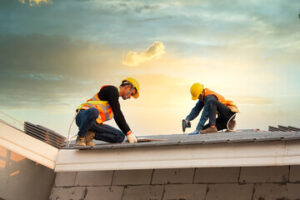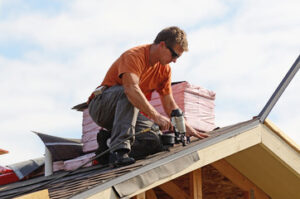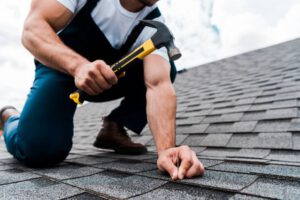Roofing is the material that covers and protects the structural frame of a building. It may be made of a wide range of materials. The design of a roof assembly requires knowledge of available material options and the experience to integrate these options into a comprehensive building enclosure and mechanical system design. for more information, click the link https://www.myprestigeexteriors.com/ provided to proceed.
Weather protection when roofing is essential to ensure the safety of both the roofers and the homeowners. The goal is to make sure that the home can withstand harsh conditions such as rain, wind and snow. This can be achieved with a variety of different roofing materials.

The roof should be able to repel heavy rain, thunderstorms, hail, high winds and heat or cold. Additionally, it should be able to resist ice dams and other conditions that can lead to the formation of water leaks.
In addition to the roofing material, other weather protections such as ice and water shielding should be installed along with flashing to help prevent moisture from seeping into the plywood, insulation or drywall of the home. This is also an important step in preventing the need for costly repairs or replacements after severe weather events. Reviewing and adding extra hurricane or flood insurance may be necessary as well. It’s best to work with a company that has experience working in areas with unique weather patterns and can help provide the necessary coverage for your home. Having this additional coverage will be worth it in the event of a serious roofing disaster. It is also a good idea to check that your homeowner’s insurance policy covers the cost of any major roofing repairs or replacements.
In a time of rising energy costs and environmental consciousness, many consumers are interested in ways to reduce their carbon footprint. One of the biggest contributors to a home’s energy consumption is the roof. A properly installed energy-efficient roof can help to lower a building’s cooling costs and improve indoor comfort.
Energy-efficient roofing systems are typically designed with a low thermal transfer coefficient (U-factor). The U-factor is a measure of the amount of heat that is transferred through a material. During the summer, a cool roof will reflect more of the sun’s rays instead of absorbing them, which can reduce the amount of energy needed to keep the structure comfortable. In addition, a cool roof will not absorb as much heat in the winter, which can help to reduce heating costs and demand on the electrical grid.
A variety of different materials are available to create an energy efficient roof, including reflective shingles, tiles, and coatings. In general, lighter-colored roofs are more effective in reflecting solar radiation than dark-colored roofs, which tend to absorb a higher percentage of it. A radiant barrier is another common energy-saving option that is applied during a reroofing project. This reflective coating looks a bit like silver paint, but it is actually a highly insulating layer that helps to decrease the heat flow between the attic and the rest of the house.
Proper attic ventilation is also critical in promoting a energy-efficient roof. This process allows cool air to enter the attic through intake vents located in the soffit, then rise through exhaust vents situated at the top of the attic. This natural circulation process prevents extreme heat buildup in the attic, which can cause a number of different problems.
A well-ventilated, energy-efficient roof can help to reduce a homeowner’s energy bills, and may even help to increase the value of the property. Increasing numbers of prospective homebuyers are looking for properties with sustainable features and are willing to pay extra for those that have been crafted with efficiency in mind. This type of roofing is also a good investment and can often be funded by tax credits and rebates, which may be offered at the federal, state, or local level.
The roof is one of the most important aspects of any home or business. It protects against rain, snow, sunlight, wind, and extreme temperatures, but it also adds to the overall aesthetic of a building.
Aesthetic considerations are important when choosing roofing materials, colors, and accessories. Light-colored roofs, for example, can reflect sunlight and create a cool, energy-efficient environment. Darker roofs, on the other hand, can offer a dramatic look that complements many architectural styles. Roof accessories, like skylights, dormers, and chimneys, can also be designed to create a visually appealing exterior.
Aesthetics aren’t the most important factor when replacing your roof, but they are a key element to consider. A well-designed, aesthetically pleasing roof can enhance the appearance of your home or business, add curb appeal, and even increase its value. Additionally, homeowners and occupants generally derive personal satisfaction from living in a beautifully designed and maintained home or office. In addition, some communities have aesthetic requirements for roofs in order to maintain a harmonious and attractive appearance throughout the neighborhood. This can contribute to overall community pride and satisfaction.
No part of a home is more exposed to the elements than a roof. It gets assaulted with wind, rain, hail, bitter cold, intense heat, and strong sunlight. It can also suffer damage from falling trees and other objects. That’s why a good-quality, beautiful, durable roof is an investment worth making.
Unfortunately, even with strict safety laws and inspection programs in place, construction workers continue to get hurt and die from working at heights (including roofs). However, many of these incidents are preventable by using fall prevention equipment and systems.
While it may be tempting to skip the cost of this vital equipment, investing in it will pay off down the line when it protects your crew members from a life-altering fall. It’s best to do your research on the newest roof fall protection technologies. A monthly Internet search or a visit to your safety equipment vendor are both great ways to keep up with what’s new in this field.
A quality safety harness is a must for anyone venturing on a roof. Choose one that fits snugly around your torso and waist to keep you secure, but leave your arms and legs free to move about the rooftop. If possible, choose a bright-colored harness so it’s easier to see against rooftops with dark materials on them.
Other important safety items include eye protection, hard hats, and slip-resistant shoes. Ensure that these tools are properly maintained to reduce the risk of accidents from worn-out parts or improper use. Likewise, it’s essential that your crew members have regular toolbox talks to discuss the latest safety protocols and identify any hazards on the roof.
With the right equipment and safety procedures in place, your roofing company can deliver exceptional results to homeowners. It’s crucial, though, to keep up with industry trends and technology so you can offer your clients the most valuable roofing services available.
Roofing materials and designs play an important role in a building’s energy efficiency. They affect heating and cooling costs and contribute to a building’s overall energy consumption. By selecting energy-efficient materials, you can help reduce your energy costs and impact on the environment.
For example, cool roofs use a special material to reflect sunlight instead of absorbing it. This can lower the roof surface temperature and reduce a building’s air conditioning requirements. It can also help lower energy bills and decrease the amount of stress on a building’s electric grid during periods of high demand.
Another energy-saving option is above sheathing ventilation (ASV), which consists of an air space between the roof tiles and roof sheathing. This system allows excess heat to dissipate and prevents warm air from seeping into cooler areas of the house, such as attics or garages. Many types of energy-efficient roofing qualify for credits and rebates, so check with your local government or utility provider. To ensure the proper installation of these systems, you should always work with a professional roofing contractor.
There are many home improvement projects that can boost your curb appeal. For example, installing a new mailbox, painting the front door, or adding sconces to your porch can give your home a fresh look. However, one of the most important improvements you can make to your home’s exterior is a new roof. This is because a new roof will increase your home’s curb appeal, making it more attractive to potential buyers.
Curb appeal is the perception a person has of a piece of real estate when they first see it from a street or sidewalk. Real estate agents often stress the importance of curb appeal when trying to sell a house or property, as it can have a major impact on how fast the property is sold and at what price.
The good news is that curb appeal can be achieved with relatively inexpensive tasks. Homeowners may also find that improving their home’s curb appeal can be a fun and rewarding project.
When it comes to roofing, the color and style play a big role in your home’s curb appeal. For example, if you have wooden or rock siding on your home, you will want to choose a roof that complements it. Additionally, if you have a metal or clay tile roof, you will want to ensure that the tiles match your siding and the rest of your house’s exterior.
In addition to the roof color, other factors that can affect your home’s curb appeal include the type of material and the shape. For instance, a cedar or redwood wood shake roof will add a rustic charm to your home, while a metal shingle roof will give your home a sleek and modern appearance.
In addition to the roof color and the style, your house’s curb appeal can also be impacted by its size, location, and landscaping. A well-maintained and quality roof will enhance your home’s curb appeal, while an outdated and damaged roof can have the opposite effect. Increasing your home’s curb appeal will also help you to get a better return on your investment when it comes time to sell.






